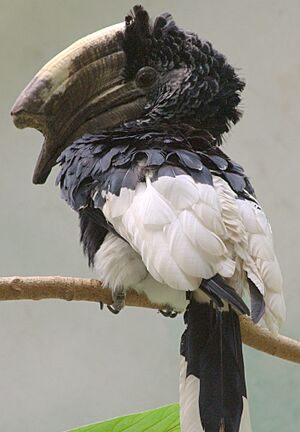Black-and-white-casqued hornbill facts for kids
Quick facts for kids Black-and-white-casqued hornbill |
|
|---|---|
 |
|
| Conservation status | |
| Scientific classification | |
| Genus: |
Bycanistes
|
| Species: |
subcylindricus
|
 |
|
| Global range Year-Round Range Summer Range Winter Range | |
The black-and-white-casqued hornbill (Bycanistes subcylindricus) is a large bird known for its black and white feathers. It is also called the grey-cheeked hornbill. This bird has a very big, dark beak with a special growth on top called a casque. Female hornbills are a bit smaller than males and have a much smaller casque.
These hornbills are monogamous, which means they have only one partner for life. They build their nests inside holes in trees. A female hornbill usually lays one or two eggs. Their main foods are figs, other fruits, insects, and small animals they find in trees. This hornbill is quite common and is not considered endangered. It is listed as "least concern" by the IUCN Red List of Threatened Species.
Contents
What Kind of Bird Is It?
The black-and-white-casqued hornbill belongs to a group of birds called Bycanistes. This group includes six types of hornbills that live in Africa, south of the Sahara Desert. All these birds have black and white feathers. Most of them are frugivores, meaning they mainly eat fruit.
The Bycanistes group is related to another group called Bucorvus, also known as Ground Hornbills. Many birds in the Bycanistes group have a casque, which is a helmet-like growth on their beak. This casque is usually bigger on males than on females. The closest relative to the black-and-white-casqued hornbill is the Brown-cheeked hornbill. They live in similar places.
What Does the Hornbill Look Like?
The black-and-white-casqued hornbill is a medium-sized bird. It is about 60 to 70 centimeters (24 to 28 inches) long. Its wings can spread out from 70 to 96 centimeters (28 to 38 inches). You can easily spot it by its black feathers on its upper body and wings. Its lower body and parts of its wings are white. It also has some black feathers mixed in with the white ones on its tail.
Males have a yellowish-brown beak and a flat, enlarged casque. Females have a smaller casque and a black beak. Scientists are still not sure what the casque is for, especially for males.
A cool fact about this hornbill is that its eyes can move a lot! Most birds have to move their whole head to look around. But the black-and-white-casqued hornbill can move its eyes inside their sockets. It can also show how it feels by moving the feathers on top of its head. This helps it communicate its mood.
Males usually weigh between 1 kilogram (2.2 pounds) and 1.5 kilograms (3.3 pounds). Females are a bit lighter, weighing between 1 kilogram (2.2 pounds) and 1.25 kilograms (2.75 pounds).
Where Do Hornbills Live?
The black-and-white-casqued hornbill lives in forests in central and western Africa. You can find them from western Kenya all the way to Côte d'Ivoire. There is also a small group living in northern Angola.
Most of these hornbills in West Africa live in Ivory Coast. Smaller groups are found in nearby countries. In Central Africa, you can mostly find them in Uganda, Kenya, and Cameroon. There are also smaller groups in Gabon, Tanzania, and Central Africa. These birds love tropical areas with lots of forests. They usually stay in trees and are rarely seen on flat ground.
How Do Hornbills Behave?
What Do Hornbills Eat?
The black-and-white-casqued hornbill mostly eats fruits. This includes small fruits or pieces of bigger ones. While many hornbills are known for eating fruit, these birds can also hunt small animals. They have been seen catching lizards and even eating the eggs of other birds. Most of their fruit diet comes from figs.
Interestingly, these hornbills do not drink water directly. They seem to get all the water they need from the fruits they eat. They are very good at using their beak to handle food carefully. They can even move food skillfully down their throat.
Gallery






